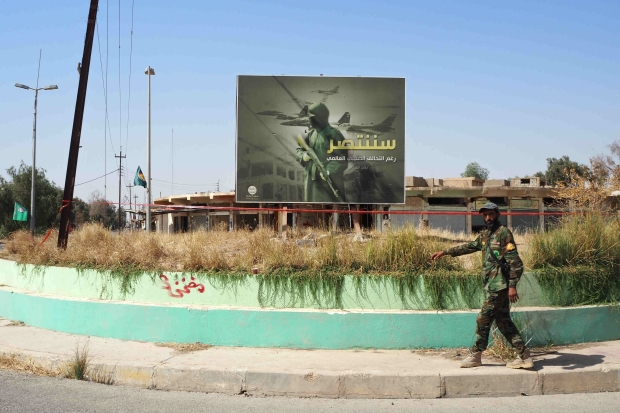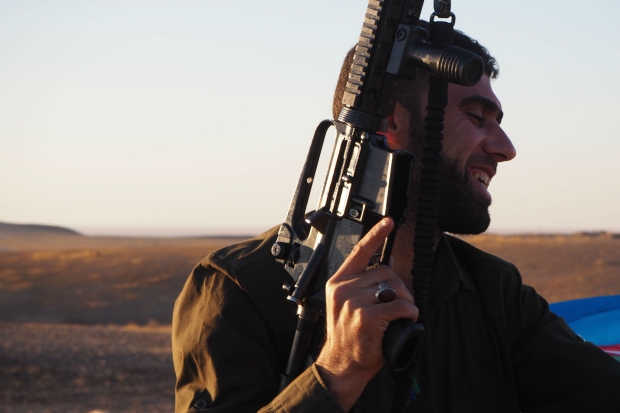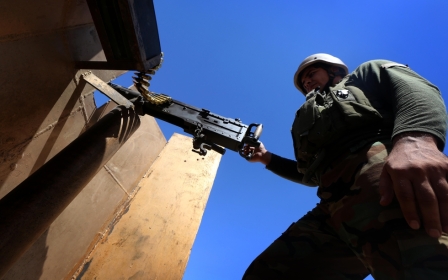The hunt for rogue IS fighters in Iraq's vast desert
Whilst many observers further afield are celebrating the military defeat of the Islamic State group, remnants of the group are already proving an ability to survive in desert hide-outs, even staging deadly attacks on Iraqi forces.
Four Hashd al-Shaabi fighters were killed and a further two injured on Tuesday evening after a military convoy scouring villages south-west of Kirkuk for IS militants was ambushed by rogue elements of the now largely defeated group.
“The order came for several Hashd Turkmen Brigades to mobilise after intelligence reports detailing IS presence in rural areas between Hawija and Bashir were received,” the head of media for the Hashd al-Shaabi forces in northern Iraq, Jawdat Assaf, told MEE.
“Daesh were hiding in tall grasses beside the roadside and, when they saw the convoy approaching the village of Yaragun, they ambushed our forces, running out from the grasses and opening fire on the vehicles,” he said, using the Arabic name for IS.
The first vehicle in the convoy took the brunt of the assault, with four of its occupants killed and the other two injured. In the ensuing fighting, the Hashd forces killed five IS members, Assaf said.
Within a few hours, a video was circulated on Facebook showing bodies of several slain militants. Stripped to their underwear and thrown across the bonnet of a Humvee, these were driven into Bashir, the hometown of the slain soldiers, which lies some seven kilometres from Yaragun.
More than 100 Bashir residents have been killed battling IS, including 36 civilians caught up in fighting, and anti-IS sentiment runs high in the town, with a population around 4,000.
The hunt for remaining IS members in northern Iraq is being fronted by local Hashd units who know the terrain well. But so, too, do their enemy.
“These Daesh are people who come from the surrounding villages. After Hawija was finished, they had no place left to go so they started to move between the desert and their ruined and abandoned former villages,” shouted Commander Muslim Amerli, over the noise of a four-wheel drive bumping across a track winding for miles across the barren desert.
He was leading a two-vehicle patrol at dusk just hours before the ambush near Yaragun.
“They know the area very well and are operating from hiding places but, to be honest, they are just postponing their inevitable fate,” he said. “They are actually just waiting for the day they will be captured or killed.”
They are just postponing their inevitable fate … They are actually just waiting for the day they will be captured or killed
- Commander Muslim Amerli
The ambush was the second attack in three days. Two nights earlier, and some 40 kilometres away, Amerli’s Brigade Sayyed Shorhadat had spotted 20 militants with two motorbikes in a rural area of Salah Ah Din province.
The militants had hoped to move unseen under the cover of darkness but the Hashd brigade have night vision equipment and opened fire. Three IS fighters were injured, and taken to a nearby hospital under armed guard, but the others managed to flee back into the barren landscape from which they had emerged.
“We have had fighting with the enemy every seven or eight days since the end of the Hawija operation but recently we have started spotting Daesh every few days,” said Captain Hamid Mohammed, speaking from a rural Hashd position.
“Daesh are hiding in secret places near the river and in the valleys, but they come out when they need to find food and other essential supplies.”
As the Iraqi winter sets in, making it increasingly hard for militants to live outside, Mohammed says his forces expect further clashes.
These are not former IS members now pretending to be civilians. They are active IS adherents who remain armed and dangerous, and still have access to weapons, ammunition and IEDs.
IS controlled the area for more than three years, during which time it buried secret stashes of ammunition for machine guns and heavy weaponry, along with additional weapons and IEDs in remote locations underground, which rogue militants are believed to be now utilising.
Tens of such ammunition caches have already been uncovered by the Iraqi forces, according to Assaf, but locating all these stashes in desert terrain and mountains requires time and manpower.
For now, militants are still sporadically laying IEDs on desert routes used by the Iraqi forces, returning to the pre-caliphate days of carrying out surprise attacks.
IS announced in a mid-October edition of its Al-Naba newsletter that territorial losses had reduced its role and power in the region to that of an insurgency.
This recent spate of IS attacks in northern Iraq, including two suicide bomb incidents in Kirkuk on 5 November, indicate IS’s Iraq-based adherents are now doing exactly this.
The ongoing challenge of securing desert terrain
These vast outlying areas around Kirkuk and Hawija have proved to be one of the hardest parts of northern Iraq to completely clear, and keep clear, of rogue IS fighters.
“This area was liberated two years ago but it’s very difficult to monitor,” said Amerli, standing on a hilltop outpost where the ground was scattered with empty bullet casings and dismantled IS IEDs. “But this is our locale so we know it very well. No other Iraqi forces are able to police this area like we can.”
The undulating barren expanse stretches for miles with few buildings or high spots that can be used as military outposts. At dusk, a lone farmer herds a large flock of sheep across a barren hillside.
Sporadically dotted across the desert are clusters of high-flying Shia flags that define Hashd-held military positions, mostly operating from the farmhouses of smallholdings, where animals still roam in the farmyards.
“You can see this area is not technically under complete military control because that’s just not possible, but Daesh rarely venture here because they know we are constantly moving around the area,” said Amerli, gesturing out across the desert expanse.
Known amongst his men as a fearless commander who led an extraordinary resistance from his hometown of Amerli in 2014, which was besieged by IS for 89 days, Amerli admits to often roaming the terrain alone, even at night, scanning the horizon with night-vision equipment for any IS activity.
He shrugged off concerns about IS staging any kind of serious come-back, or taking control of any territory in the area.
"I don’t believe they can ever come back like before but I am expecting an increase in terrorist attacks,” he said. “And sure, they can attack us at any time around here but we are always ready for them. We are always waiting for them.”
Hunting down IS, one by one
Since the liberation of Hawija in early October, the Iraqi forces have not only been tracking down IS militants in the desert but also in Hawija’s outlying villages where former IS members have shaved their beards and are concealing themselves amongst civilians.
A senior Hashd al-Shaabi source, speaking on condition of anonymity, told MEE that forces under the control of one military commander alone had tracked down and arrested 150 former IS militants in the Salah Ad Din and Hawija provinces, steadily working through a list of confirmed IS members, during the last month.
The town, which was IS’s last northern Iraqi stronghold, is surrounded by hundreds of kilometres of rural, desert and mountainous terrain into which militants fled in all directions as the Iraqi forces closed in. Military commanders heading the Hawija offensive knew these rogue elements would continue to cause problems after liberation.
“Just one military commander has arrested 150 but the Hashd has many commanders operating in these areas outside, so you can imagine how many more have been captured.”
Pretending to be ordinary civilians or being sheltered by family members, these men had been hoping to blend into post-IS Iraq and go undetected. The source said former IS members, who he described as dangerous criminals who continued to pose a grave threat to Iraq, could not be allowed to live freely in a country which they sought to destroy.
Middle East Eye propose une couverture et une analyse indépendantes et incomparables du Moyen-Orient, de l’Afrique du Nord et d’autres régions du monde. Pour en savoir plus sur la reprise de ce contenu et les frais qui s’appliquent, veuillez remplir ce formulaire [en anglais]. Pour en savoir plus sur MEE, cliquez ici [en anglais].







